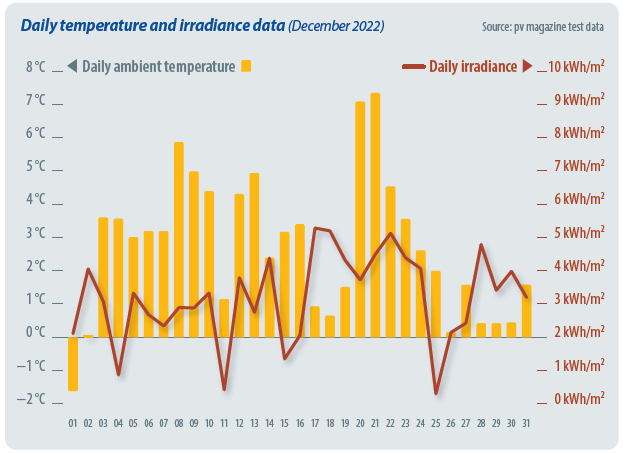pv magazine test: April 2024 Results
By George Touloupas
This article was originally published in pv magazine – June 2024 edition. Learn more about the pv magazine test here.
George Touloupas, senior director of technology and quality at Clean Energy Associates, analyzes the April 2024 results from the outdoor pv magazine test installation in Xi’an, China.
Due to a monitoring system malfunction, parts of the data for some modules in the first half of April can’t be used and have been removed to ensure that the performance results are comparable. Two new products – a heterojunction (HJT) module from Akcome and a TOPCon module from Longi – have been added to the field and their indoor test reports have been uploaded on the website. The first chart below shows the meteo station data (irradiance, ambient temperature) for April 2024.
Figure 1: Daily temperature and irradiance data - April 2024
The average bifacial boost is 8.18% for April 2024. Bifacial boost refers to the relative advantage of the average specific energy yield of all bifacial products compared to the average specific energy yield of all mono PERC products.
Table 1: Bifacial boost - January 2024 to April 2024
Monthly highlights
Four TOPCon and two HJT bifacial panels are grouped in the first rank, as their results are close to each other. HJT products haven’t shown better performance, but their average yield is roughly 0.5% higher than TOPCon, which is within our measurement tolerance. Older bifacial PERC panels have yields that are close to the more advanced n-type modules. We need more products and more data to be able to draw safer conclusions on how these technologies compare.
Table 2: Specific energy-yield ranking of n-type bifacial (TOPCon and HJT) modules - April 2024
Table 3: Specific energy-yield ranking of bifacial PERC modules - April 2024
Table 4: Specific energy-yield ranking of monofacial modules - April 2024
Energy yield measurements
The energy yield comparison among various technologies, including bifacial boost, is analyzed using products installed after the beginning of 2019.
The energy yield is given in Wh/Wp and calculated by dividing the energy produced by the module by the Pmax at STC of the module. This Pmax is the maximum STC power after a process of stabilization.
The results are grouped in categories, per solar module type.
The bifacial boost depends on a number of parameters: the bifaciality factor, the installation geometry, the albedo of the ground, the sun angle, and diffuse irradiance. The ground in this case is gray gravel.
Figure 2: Specific energy yield of n-type bifacial (TOPCon and HJT), bifacial PERC, and monofacial modules - April 2024
Energy yield related to top performer in each category.
Figure 3: Relative yield of different technologies - April 2024
Test cooperation
pv magazine test is a cooperative effort involving pv magazine, CEA, Gsolar and Hoymiles. All testing procedures are carried out at Gsolar’s test laboratory in Xi’an, China. CEA supervises these tests and designed both the indoor and outdoor testing procedures.



































